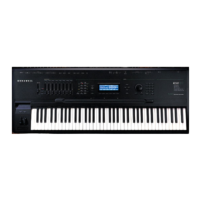Multi Edit Mode
Velocity Page
5-6
Curve
e Curve parameter lets you taper the velocity response. e default setting is Linear,
which means that the output velocity changes directly proportionally to the played velocity.
Expand produces a curve that is less steep than the linear curve at keystrike velocities below
64, and steeper than the linear curve at keystrike velocities above 64. In other words, when
you’re playing softly, you’ll notice velocity dierences less than with a linear curve, while
when you’re playing hard, you’ll notice velocity dierences more.
Compress produces a velocity curve that is the opposite of the expanded curve—that is,
you’ll notice velocity dierences more when you’re playing softly than when you’re playing
hard.
Crossfade is designed to be used in tandem with the Reverse Crossfade curve, enabling you
to perform smooth crossfades between dierent programs.
Bump tapers velocity response to resemble a bell curve, so that notes are loudest when your
keystrike velocity is 64. Notes get softer as the keystrike velocity approaches 0 or 127.
e next four velocity curves are Reverse Linear (Rvrs Linear), Reverse Expand (Rvrs
Expand), Reverse Compress (Rvrs Compress), and Reverse Crossfade (Rvrs Crossfade).
ese taper velocity in reverse of the ve curves we just covered. For example, Reverse
Linear’s response is such that striking a key harder will produce a lower volume, striking it
softer will produce a higher volume, and so on. is provides a convenient way to achieve
negative scaling, by letting you set one parameter instead of two.
Note Map
Note Map allows you to arrange the notes of a Zone across the keyboard in dierent
congurations. See below for details on each of the Note Map settings:
Off
With Note Map set to O, keys in the Zone will not play notes. is can be useful when
controlling external MIDI equipment, you may wish to send controller values without notes.
Linear
With Note Map set to Linear, all keys produce notes as played. is is the default setting.
Inverse
With Note Map set to Inverse, the keyboard plays upside-down, with the highest note being
played by key A0 and the lowest note being played by key C9.

